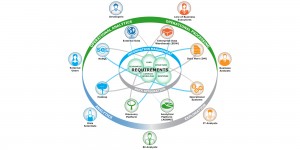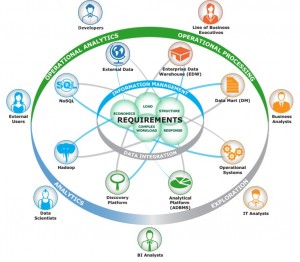Since its introduction, the idea of “big data” has been widely associated with a single data management platform—Hadoop. Hadoop’s popularity as a platform to store and process large amounts of multistructured data probably has a lot to do with this association. However, Hadoop is not the full answer to the question of “what is big data?”
The term “big data” describes a way to look at new sources as well as the approach that organizations take in placing that information under management. Big data has attracted a wide range of application innovators as well as many folks just looking for an alternative to relational databases and data warehouses. The EMA/9sight surveys use a deliberately broad definition of big data to inspire end users to think beyond the box of Hadoop. The survey explores the wide range of ways in which nontraditional data, often in combination with more traditional types, has enabled new or improved business processes.
Beyond even processes, one of the most important concepts to emerge in conjunction with the growth of big data is the idea of being a data-driven organization or culture. Like big data, “data-driven” is a term that is widely used, but loosely defined. The EMA defines data-driven organizations as:
[c]ompanies that have either fully integrated data or started with data as the basis for their strategic and operational thinking. These organizations use data and information for finance, marketing, sales, and operations decisions and have built new business models in existing markets using data and information. Data-driven organizations have the following attributes: widespread access to and usage of data, integration of data analytics into strategic decision-making and pervasive usage of information in tactical decision-making.
Our survey results show that the idea of being data-driven has gained significant momentum among practitioners of big data. More than 60% of respondents assert that their organizations have already adopted a data-driven strategy. And nearly 20% of respondents described being data-driven as already being a vital part of their business.
It is clear that the drivers behind this shift are closely related to the drivers behind the emergence of big data overall. Organizations are dealing with unprecedented volumes of data in new formats and structures. They face a business landscape that is itself increasingly data-driven and that requires deeper understanding and faster decisions than ever before.
The correlation between big data and being a data-driven is clear to see in our survey results. Respondents with larger percentages of big data in their organizations were also more likely to have adopted data-driven strategies, and vice versa. Additionally, the findings indicate significant growth in workforce access to data-driven initiatives. Currently, half the respondents reported access rates of less than 15% of the workforce. By 2016, more than a fifth of the respondents expect to have more than 50% of their workforce accessing data-driven initiatives.
 Without a doubt, a data-driven organization must be one that provides timely access to data to business analysts as well as data scientists. As data becomes more deeply embedded in everything a business does, the need for solutions such as Platfora Big Data Discovery becomes more apparent. As noted above, one of the reasons that Hadoop should not be completely synonymous with big data is that an effective big data environment draws on a whole ecosystem of technologies and approaches—one similar to the EMA Hybrid Data Ecosystem. Platfora has established itself as an important part of a hybrid ecosystem, empowering organizations to make the transition to a more data-driven approach.
Without a doubt, a data-driven organization must be one that provides timely access to data to business analysts as well as data scientists. As data becomes more deeply embedded in everything a business does, the need for solutions such as Platfora Big Data Discovery becomes more apparent. As noted above, one of the reasons that Hadoop should not be completely synonymous with big data is that an effective big data environment draws on a whole ecosystem of technologies and approaches—one similar to the EMA Hybrid Data Ecosystem. Platfora has established itself as an important part of a hybrid ecosystem, empowering organizations to make the transition to a more data-driven approach.


